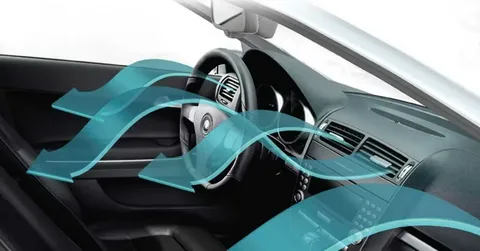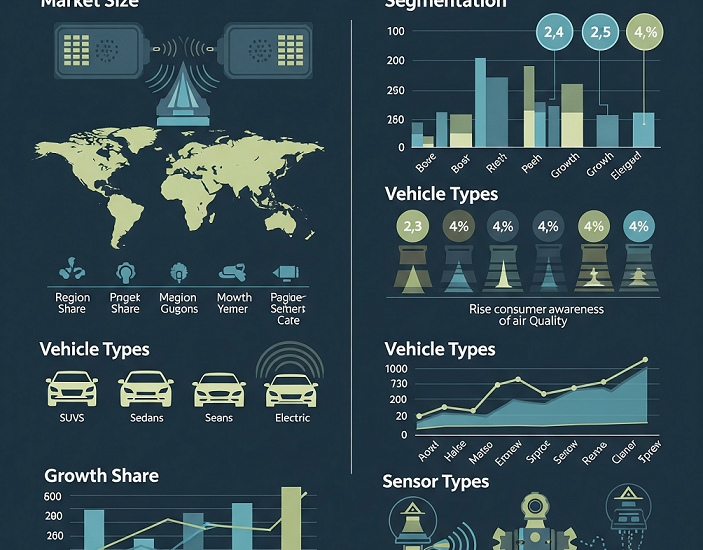The global automotive cabin air quality sensors market is projected to grow from USD 1.19 billion in 2025 to USD 3.94 billion by 2035, reflecting a CAGR of 12.7%. The increasing demand for enhanced cabin air quality in vehicles is driving market growth, particularly as consumers and regulatory bodies place greater emphasis on health, comfort, and environmental standards.
As vehicles become more connected, electric, and autonomous, a quiet but vital shift is also occurring inside the cabin. Beyond infotainment upgrades and ergonomic seating, automakers are focusing on something far more essential: the air we breathe. At the heart of this transformation lies a small but powerful component—the automotive cabin air quality sensor.
Invisible to passengers and often overlooked in spec sheets, these sensors are emerging as a critical line of defense against environmental pollutants, allergens, and interior air stagnation. In an age where wellness is as important as horsepower, cabin air quality sensors are becoming indispensable to vehicle design.
Get Ahead with Our Report: Request Your Sample Now!
https://www.futuremarketinsights.com/reports/sample/rep-gb-6034
Beyond Ventilation: The Intelligence of Clean Air
Cabin air quality sensors go far beyond regulating temperature or airflow. These sensors detect particulates (PM2.5), volatile organic compounds (VOCs), CO₂ levels, and other harmful gases. When thresholds are crossed, the vehicle’s HVAC system can automatically adjust filtration modes, activate air recirculation, or issue real-time alerts to the driver.
This proactive air management enhances passenger comfort while also protecting long-term health—especially in urban areas where pollution levels regularly exceed safety standards. For allergy sufferers and families with children, clean cabin air is more than a luxury—it’s a necessity.
Overshadowed by Screens, But Critical to Experience
As dashboards grow flashier and autonomous features dominate marketing campaigns, the role of sensors remains mostly behind the scenes. Yet, cabin air quality sensors work continuously to ensure the driving environment remains healthy—regardless of what’s happening outside.
While exterior technology gets the spotlight, it’s interior quality that directly influences how people feel during a journey. Whether commuting through traffic, traveling long distances, or idling near construction zones, passengers increasingly expect air purity that rivals indoor environments.

Wellness Meets Vehicle Design
Cabin air quality is no longer an afterthought. Automakers are now designing climate control systems with health-focused capabilities, integrating HEPA filters, ionizers, and AI-powered air management—all driven by sensor feedback. In this environment, air quality sensors act as the brain behind the breath, enabling personalized climate strategies that adapt to driving conditions, passenger load, and exterior pollutants.
These sensors are also key in the growing category of wellness cars, where biometric feedback, mood lighting, and aromatherapy systems are orchestrated to deliver a restorative in-cabin experience.
A Strategic Edge in Urban and Emerging Markets
Air quality issues are global—and growing. As cities grow denser and industrial activity rises, air pollution has become a top health concern. For automakers, integrating robust cabin air quality sensing offers a meaningful point of differentiation—especially in markets where environmental conditions demand added protection.
This is also critical in electric and shared vehicles, where longer idle times and frequent cabin turnover increase the need for real-time air monitoring and purification. Clean air is quickly becoming a benchmark of premium and practical vehicle design alike.
Exhaustive Market Report: A Complete Study
https://www.futuremarketinsights.com/reports/automotive-cabin-air-quality-sensor-market
Smarter Systems, Safer Journeys
Next-generation sensors are bringing intelligence to air management. By linking to GPS data and weather systems, they can anticipate areas of high pollution and adapt ventilation preemptively. When paired with in-cabin occupant detection, these systems fine-tune airflow and filtration on a per-passenger basis, maximizing comfort and minimizing exposure.
Some platforms even log air quality data over time, offering insights to drivers or enabling fleet managers to prioritize vehicle health in shared mobility settings. As regulations tighten and consumer awareness grows, these capabilities are shifting from nice-to-have to standard.
The Quiet Guardian of Cabin Wellness
You won’t hear it. You won’t feel it. But the cabin air quality sensor is quietly working every time you drive—filtering what you can’t see, and safeguarding what you can’t measure with the naked eye.
Ignore it, and the vehicle becomes vulnerable to unseen risks. Invest in it, and you redefine what it means to travel well. In the new era of automotive design, wellness is not just an amenity—it’s an expectation. And at the center of that expectation is a tiny sensor making sure every breath you take on the road is a cleaner, safer one.





